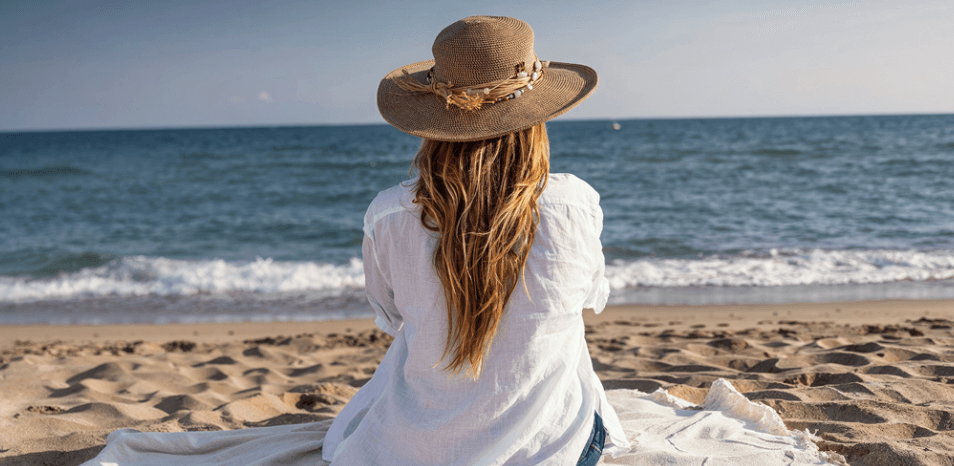Summer Skincare: Safe Sun
London Dermatology | 10 July 2024
Hair, nails and the rest of the skin grow at a certain rate. This is your natural repair rate. Your sun accumulation rate depends on the strength of the sun and the fairness of your skin colour. Sun accumulation rate is highest when fair skin is exposed to strong sunlight. When the sun accumulation rate is faster than the natural repair rate, a solar debt develops. As a solar debt increases, the risk of melanoma, and other cancerous and non-cancerous blemishes rises. When the natural repair rate is faster than the sun accumulation rate, an existing solar debt can be reduced. In this way. the body can repair sun damage.
Humans need some (but not too much) sunshine. Some sunshine is necessary for normal Vitamin D production. Vitamin D is essential for good health, especially for healthy bones. Inadequate amounts of vitamin D are also associated with an increased prevalence of hypertension & heart disease, multiple sclerosis, schizophrenia, tuberculosis, psoriasis and 16 different types of internal cancer (including colon, breast, ovarian, prostate & pancreatic cancers and lymphoma).
However fair you are, it is still possible and desirable that you should enjoy sporting activities and holiday destinations anywhere in the world. Whilst doing these, you can avoid the ill-effects of the sun by following these steps:
1. Never burn. Never allow the sun to make you itch, go red or peel.
2. Seek the shade. Wear hats and sunglasses. Use a “rash vest” when swimming. Heatbathing in the shade of an umbrella is acceptable.
3. Avoid deliberate tanning. Remember freckles are an injury response of the skin. Try to return from holiday much the same colour as you go.
4. Avoid the midday sun (i.e. I lam til 3pm). When your shadow is shorter than you are, please try not to be in the sun at all.
5. Be careful of reflected sun from sand, water, concrete, snow and even clouds. Take extra care at high altitudes or if there is a cooling breeze, e.g. sailing. Babies and children need to take extra care. Don’t forget to reapply sunscreen to your lips after eating and to your hands after hand washing!
6. Use sunscreen on unavoidably exposed areas, especially the face, ears, V of neck and backs of hands. Reapply every two hours. Reapply after bathing. Use sunscreen generously. 7. Even at the equator, no sunscreen is necessary when the sun is low in the sky (i.e. within an hour or so of sunrise or sunset). 8. Sunscreens with a high SPF number and four stars are best. The SPF number is a measure of the protection against UVB rays. The stars are a measure of the protection against UVA rays.
9. Organic chemical sunscreens, such as Vichy 50+ or Nivea DNAge SPF 50 are suitable for most situations. Neutrogena Ultra Sheer Liquid Daily Sunblock SPF 70 Broad Spectrum or Chantecaille Ultra Sun Protection SPF 50 PA+++ are agreeable for use on the face. Please remember that in strong sunlight organic chemical sunscreens only last for 90 minutes. In strong sunlight they should be reapplied every 90 minutes.
10. Mineral sunscreens contain titanium dioxide or zinc oxide. A single application of a mineral sunscreen will give all day protection, provided it is not wiped off or sweated off.
11. Mountaineers, babies and children are best to use a mineral sunscreen. For most purposes, Soltan 50 liquid or Soltan Kidz SPF 50-r stick are agreeable and easy to use.
12. Do not squint your eyelids or eyebrows to shade your eyes from sunlight. If you do, the sun will cook this expression into the permanent lines of your face. To avoid this, wear sunglasses. Sunglasses also help to protect your sight.
13. Never use sunbeds.
14. Fake tan is harmless. Good ones include Clarins Radiance Plus Golden Glow Booster Fake Tan Drops, Lancome Self Tan Flash Bronzer and St Tropez Gradual Tan.
15. Please take extra care if you have red or auburn or fair hair, green or blue eyes and especially if you also have many moles or freckles.

